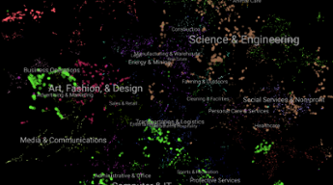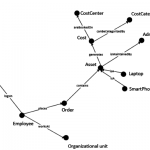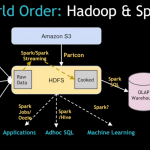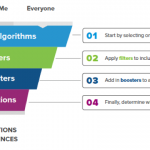Google Brings Machine Learning to the Staffing Industry
— November 18, 2016

Just a couple of weeks ago, Facebook made industry news when technology reporters discovered a Jobs tab on their business page. The social network later confirmed that it was experimenting with a suite of sourcing tools to capitalize on the boom in social recruiting. Workforce industry experts believe that Facebook may be trying to muscle in on LinkedIn’s sacred grounds. However, even bigger revelations came November 15 when Google announced its own foray into the realm of talent acquisition — a move that staffing insiders have been predicting for some time. The fascinating twist with Google is that the Internet giant has no plans to build a standalone technology, such as a branded applicant tracking system (ATS), online recruitment platform or vendor management system (VMS). Instead, Google is offering “Cloud Jobs API,” which allows workforce technology developers to integrate robust machine learning features into their systems.
What Is Cloud Jobs API?
Google is promoting its targeted API as a powerful job search and discovery platform dedicated to improving processes in the talent industry. Machine learning forms the core of the technology and its potential boon to staffing professionals. Google describes the innovation on its site:
Company career sites, job boards and applicant tracking systems can improve candidate experience and company hiring metrics with job search and discovery powered by sophisticated machine learning. The Cloud Jobs API provides highly intuitive job search that anticipates what job seekers are looking for and surfaces targeted recommendations that help them discover new opportunities.
To ensure that users receive the most relevant search results and recommendations, the API relies on Google’s advances in machine learning to understand how job titles and skills correlate. It then compiles the data to determine the closest match between job content, location and seniority.
The Value of Cloud Jobs API
Meaningful Search Results
When Google first launched its search functionality, it revolutionized the Internet. It masked cutting-edge algorithms in a simple interface, which delivered the most comprehensive and relevant results available — and disrupted an entire industry. Google is no longer just a technology solutions provider, it’s become a cultural institution. Now, it’s expanding that reach into our industry.
Recruiters today still face challenges with cumbersome job boards, muddled sourcing systems and attempts to cull vital information from a lot of digital noise. That’s precisely what Google intends to help them overcome.
As Google explains: “Job postings are often worded in industry- and company- specific jargon that job seekers don’t search for. Cloud Jobs API provides intuitive job search that surfaces relevant opportunities by leveraging a complete graph of how job titles, skills, and seniority relate to one another.”
Dynamic Job Discovery
The inherent machine learning in Cloud Jobs API promises to bring big data directly to users, while compacting it into right-sized data. Google’s platform will monitor job searching behavior and the data present in career path progressions to suggest opportunities. It will also recommend additional roles that are aligned to a job seeker’s skill sets and interests. As the API collects more information, it can render more accurate assessments.
Because cultural fit has taken precedence with candidates, recruiters, hiring managers and contingent workforce leaders alike, Cloud Jobs API could streamline the process of creating ideal matches.
Simple Integration and Other Features
Simplicity in user functionality has always been a hallmark of Google. The company assures staffing industry technology providers that integrating the API is a fairly effortless undertaking. Despite this ease, however, the API will continue to support a wide range of critical features.
- Synonym and acronym expansion: The system can incorporate relevant results even when job postings are written in company specific terms, industry jargon or acronyms that candidates may not be familiar with.
- Job enrichment: Results are optimized with enhanced content that includes additional details about location, employment type, benefits and more.
- Geographical data: Tapping into the power of Google’s robust geolocation systems, Cloud Jobs API will interpret countless forms of location data to help users refine their searches. “From street address to colloquial regions (Bay Area, Research Triangle) to precise geo-coordinates,” Google writes, the platform will enable “fine grained job filtering based on distance and commute times.”
- Seniority alignment: Google says the API understands the seniority requirements of positions and returns only the relevant results.
- Dynamic recommendations: The API encourages users to mark which jobs they liked and which they considered poor fits. The “recommendation engine” records these inputs and factors them into future searches for optimized suggestions.
How Does Cloud Jobs API Work?
Ontological Structure

“At the heart of Cloud Jobs API,” Google explains, “there are two main proprietary ontologies that encode knowledge about occupations and skills, as well as relational models between these ontologies.” For the sake of avoiding confusing tech terms, let’s just call these “ontologies” data models.
The first data model deals with occupation. It includes about 30 general job categories (e.g., accounting and finance, human resources, hospitality, etc.), over 1,000 occupational families (e.g., database administrators), and 250,000 specific job titles.
The second data model focuses on skills. Google claims that it can define and organize about 50,000 hard and soft skill sets with different types of relationships. Basically, it seems to produce an analogy along the lines of “this hard skill is related to this soft skill.” Or, as an example, we could say “customer service is related to strong interpersonal communication skills.”
Machine Learning
Of course, the breakthrough of Cloud Jobs API comes from access to Google’s machine learning algorithms, which play a predominant role in driving the performance of talent acquisition strategies. The first step involves cleansing job titles. Google’s API is programmed to standardize the titles it sees, which represents a huge benefit to job seekers and job posters.
The APi initially removes language not directly related to the occupation’s definition. This includes location, employment type, salary details, company names, advertising phrases and “administrative jargon.”
Next, the API takes the scrubbed job descriptions and attempts to recognize actual occupations from vague expressions. Google illustrates the process with an example: “The title ‘retail sales’ maps to the broad category ‘Sales and Retail,’ while a ‘flooring installer’ job title encompasses ‘carpet installer,’ ‘floor layer,’ and ‘tile and marble setter’ occupation families.” The system can detect titles that are not occupations and assign a confidence score to the mappings.
After these processes, machine learning takes over and supports the following functions:
- Identifying an occupation based on a candidate’s search queries and then matching them to the occupation data model with a confidence score.
- Mapping job titles in postings to relevant roles in the occupation data model with a confidence score.
- Detecting specific skills in candidate search queries and matching them to values in the skills data model.
- Extracting relevant skills from job postings and matching them to values in the skills data model.
- Computing the relationship between occupations and skills.
Who’s Already Using Cloud Jobs API?
According to ERE Editor-in-Chief Todd Raphael, three big industry firms have already incorporated the API into their systems: Dice, CareerBuilder and Jibe. In his article, Todd provides insights from this early batch of Google partners. The results enjoyed by CareerBuilder are particularly compelling and seem to hint at great potential for the API.
Dice. The company says it was selected “specifically for its technology focus and position in the technology community.”
CareerBuilder. Google says that CareerBuilder created “a prototype in just 48 hours, found improved, more accurate results when compared to its existing search algorithm.” Google gives an example of a search for “part time” and how the results are “richer” because of the use of synonyms like PT. CareerBuilder appears to be just testing the tool and later expanding it to greater use among its customers.
Jibe, whose CEO Joe Essenfeld says, “With the launch of Google Cloud Jobs API, Google machine learning will become the standard for career sites” and is a cornerstone of the company’s candidate experience platform. Jibe says career site/ATS users — job candidates, in other words — will get better search results as Jibe integrates Google with career sites.
A New, Data-Driven Frontier for Hiring and Staffing
Google’s Cloud Jobs API is definitely a gift to staffing industry professionals and candidates. Workforce solutions providers will be able to integrate the platform into their own systems to create a more vivid way to hire exceptional talent. However, I believe Google’s approach has accomplished something even more important.
Staffing technology companies are facing fierce competition these days. Big VMS providers, for example, are acquiring other tech offerings and growing to levels where smaller players struggle to stay afloat. Meanwhile, lean and savvy startups have circulated new offerings into the market, such as freelance management systems, online recruitment platforms and a variety of tools that target niche groups. Existing workforce technology providers are scrambling to incorporate the latest modules and remain relevant.
Google probably could have built its own machine and just dominated the space. It didn’t. Instead, Google chose to become a great equalizer. The API gives tech players of all sizes the chance to benefit from its enhanced functionality. It will be exciting to see how this offering helps reshape our industry in the coming months and drives performance to unprecedented heights.
Business & Finance Articles on Business 2 Community
(24)












